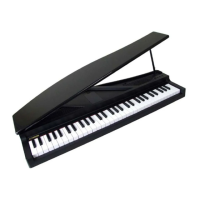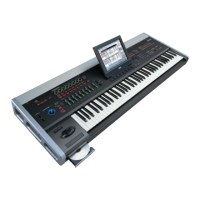Parameter guide
22
Common Tone Adjust Parameters
Unless otherwise noted, all of the Common Tone Adjust
parameters are Relative.
Note: In the list below, the items in parentheses are (value,
edit type) respectively.
Off. This means that the Tone Adjust control has no effect.
Filter Cutoff. (–99...+99, CC#74)
This scales the cutoff frequency of all of the filters at once.
For instance, in the RADIAS program, it affects both Filters
A and B.
Filter Resonance. (–99...+99, CC#71)
This scales the resonance of all of the filters at once - for
instance, in the RADIAS program, it affects both Filters A
and B.
Filter EG Intensity. (–99...+99, CC#79)
This scales the effect of the EG1 on the cutoff frequency. It
affects all of the filters at once; for instance, in the RADIAS
program, it affects both Filters A and B. –99 means no
modulation. +99 means maximum modulation in the same
direction, positive or negative, as the original Program. For
instance, if the original Program’s EG1 Intensity was set to –
25, then setting the Tone Adjust to +99 moves the EG1
Intensity to –99.
Amp Velocity Intensity. (–99...+99)
This scales the effect of velocity on the Amp level. –99
removes the velocity modulation entirely. +99 means
maximum modulation in the same direction, positive or
negative, as the original Program.
F/A EG Attack Time. (–99...+99, CC#73)
This scales the attack times of the EG1 and EG2.
F/A EG Decay Time. (–99...+99, CC#75)
This scales the decay and slope times of the EG1 and EG2.
F/A EG Sustain Level. (–99...+99, CC#70)
This scales the sustain levels of the EG1 and EG2.
F/A EG Release Time. (–99...+99, CC#72)
This scales the release times of the EG1 and EG2.
Filter EG Attack Time. (–99...+99)
This scales the attack times of the EG1.
Filter EG Decay Time. (–99...+99)
This scales the decay and slope times of the EG1.
Filter EG Sustain Level. (–99...+99)
This scales the sustain levels of the EG1.
Filter EG Release Time. (–99...+99)
This scales the release times of the EG1.
Amp EG Attack Time. (–99...+99)
This scales the attack times of the EG2.
Amp EG Decay Time. (–99...+99)
This scales the decay and slope times of the EG2.
Amp EG Sustain Level. (–99...+99)
This scales the sustain levels of the EG2.
Amp EG Release Time. (–99...+99)
This scales the release times of the EG2.
Pitch EG (EG3) Attack Time. (–99...+99)
This scales the attack times of the EG3.
Pitch EG (EG3) Decay Time. (–99...+99)
This scales the decay and slope times of the EG3.
Pitch EG (EG3) Sustain Level. (–99...+99)
This scales the sustain levels of the EG3.
Pitch EG (EG3) Release Time. (–99...+99)
This scales the release times of the EG3.
Pitch EG Attack Time–Pitch EG Release Time are
named Pitch EG, but are actually controlling EG3.
RADIAS programs do not have a fixed EG that controls
the pitch. If you want to use EG3 to control the pitch,
set a virtual patch source (Src) to EG3, and set the
destination (Dst) to Pitch.
Pitch LFO1 Intensity. (–99...+99, CC#77)
This scales the effect of LFO1 on the Pitch.
This is not valid for the RADIAS program.
LFO1 Speed. (–99...+99, CC#76)
This scales LFO1’s frequency. When the LFO is in MIDI/
Tempo Sync. is on, this adjusts the Base Note. For more
information, please see “Frequency [Hz],” on page 39 and
“Base Note (Sync. Base Note),” on page 40.
LFO1 Fade. (–99...+99)
LFO1 Delay. (–99...+99, CC#78)
LFO1 Stop. (PROG/Off/On, Absolute)
This is not valid for the RADIAS program.
LFO2 Speed. (–99...+99)
This scales LFO2’s frequency. When the LFO is in MIDI/
Tempo mode, this adjusts the Base Note. For more
information, please see “Frequency [Hz],” on page 39 and
“Base Note (Sync. Base Note),” on page 40.
LFO2 Fade. (–99...+99)
LFO2 Delay. (–99...+99, CC#78)
LFO2 Stop. (PROG/Off/On, Absolute)
This is not valid for the RADIAS program.
Unison. (Off/On, Absolute)
This Absolute parameter turns Unison on and off. For more
information, please see “Unison,” on page 25.
Number Of Voices. (2...16, Absolute)
This Absolute parameter sets the number of Unison voices.
If Unison is not On, this parameter has no effect. For more
information, please see “Number of Voices,” on page 25.
Detune. (00...99, Absolute)
This Absolute parameter sets amount of detuning between
the Unison voices. If Unison is not On, this parameter has
no effect. For more information, please see “Detune[cents],”
on page 25.
Thickness. (Off/01...09, Absolute)
This is not valid for the RADIAS program.

